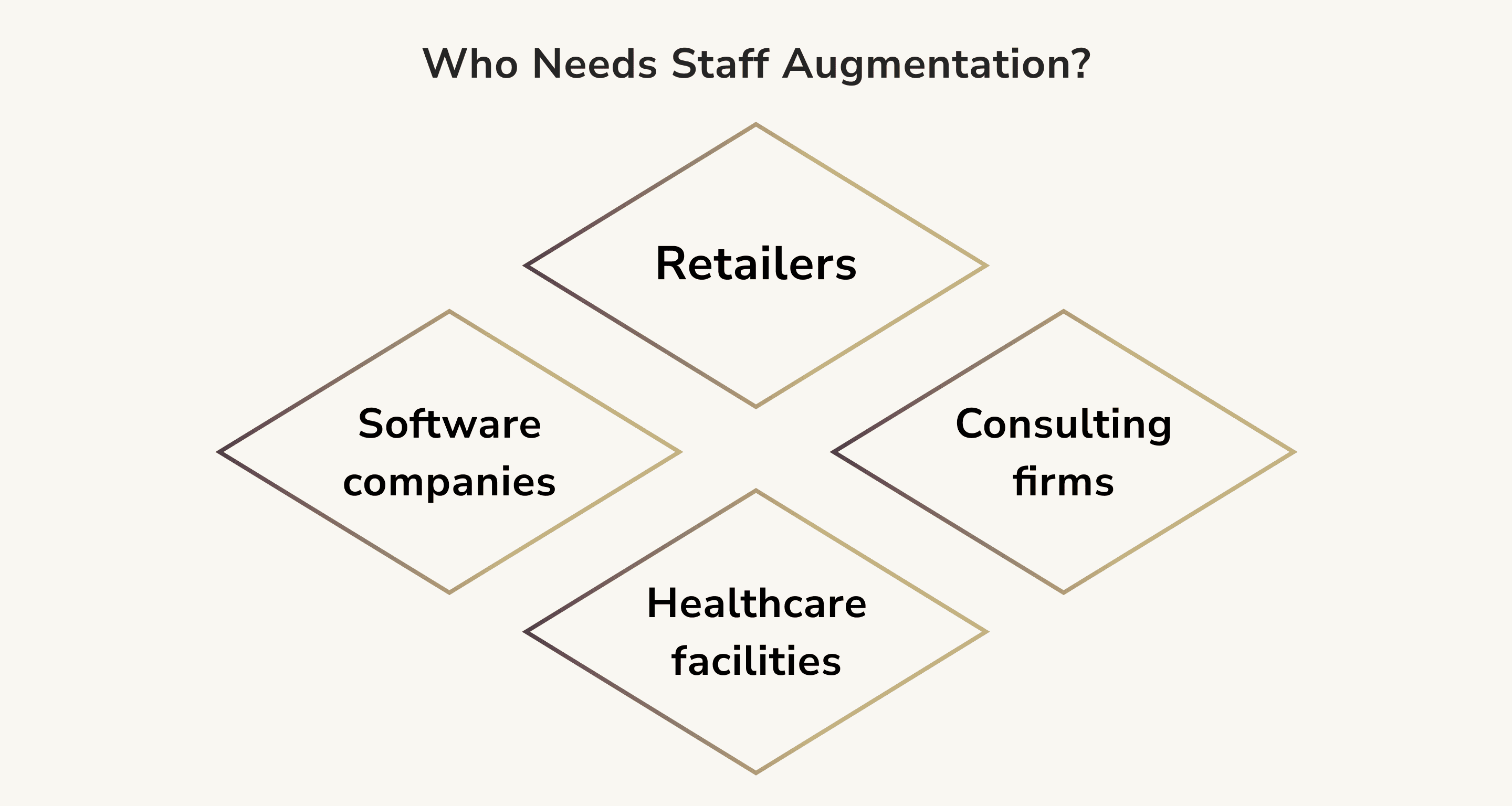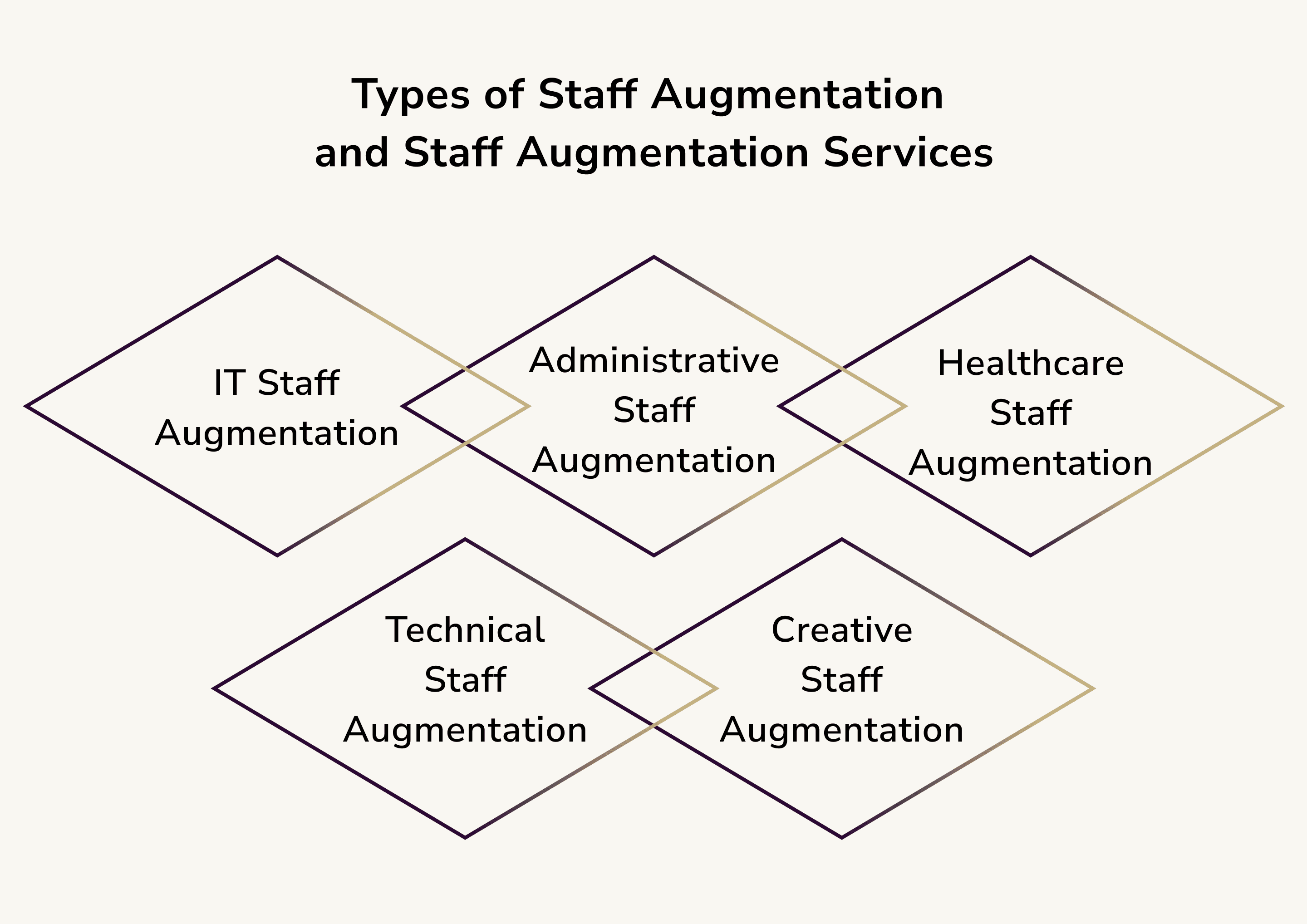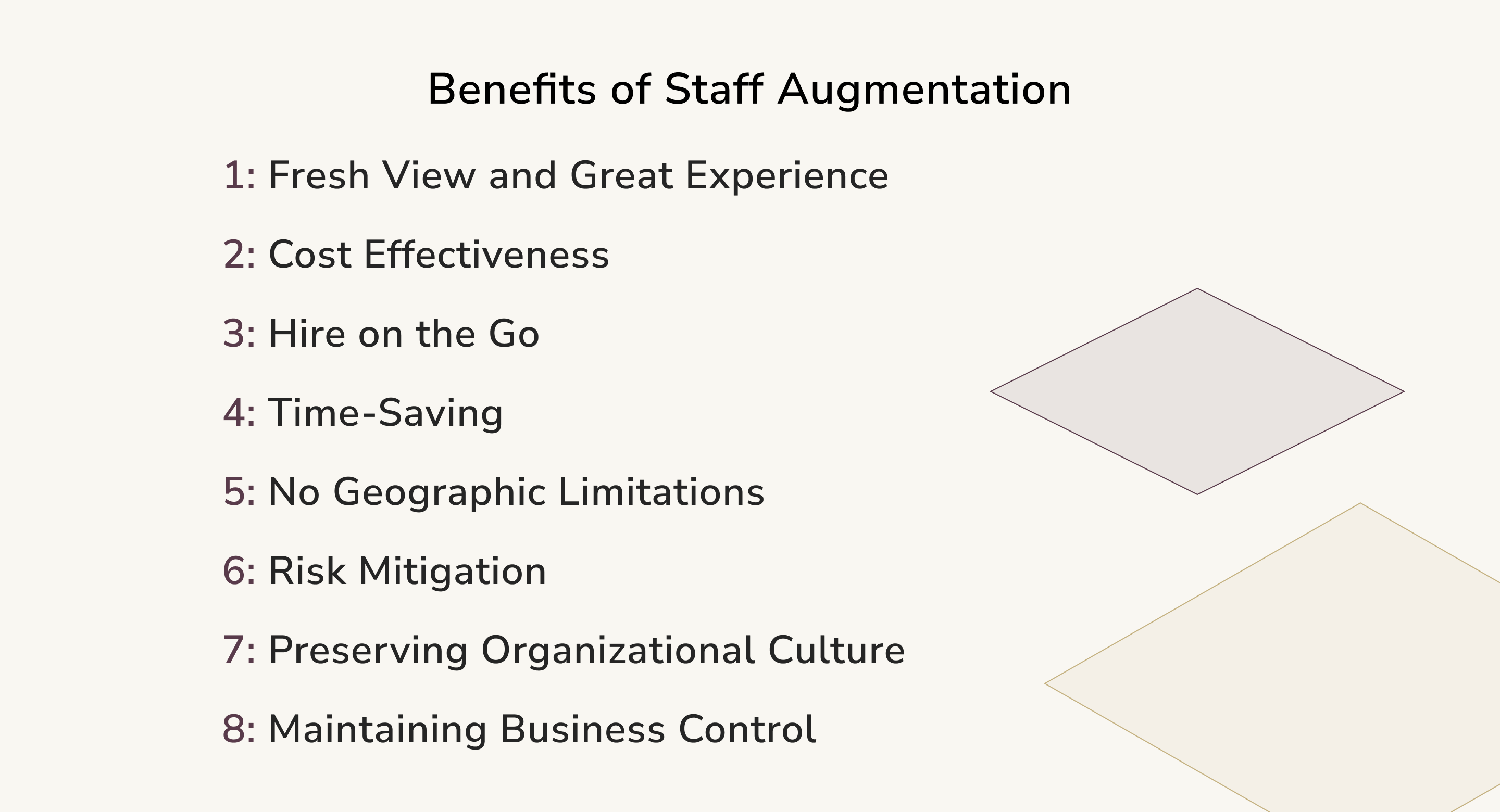What is Staff Augmentation and Why Your Project Needs It

The rapidly evolving digital landscape requires businesses to adapt quickly and scale their teams efficiently. Enter staff augmentation — a strategy that has proven highly beneficial in managing such dynamic requirements. Statista indicates the IT outsourcing market will reach $587 billion by 2027. The concept has a bright future with staff augmentation being part of IT outsourcing.
Staff augmentation is a strategic approach to hiring where you fill skill gaps in your team with contracted professionals for a set period. This model allows companies to adapt to the ebb and flow of business, scaling resources up or down as necessary. In an increasingly dynamic and specialized business environment, staff augmentation has emerged as a critical strategy for project management. It is a flexible, cost-effective solution that allows companies to create products faster and keep up with emerging technologies on the market. Staff augmentation can make the difference between a project's success and failure. It offers the ability to control your project, access specialized talent quickly, manage costs effectively, and reduce the risks of hiring permanent staff for temporary projects.
But what exactly is staff augmentation, and why might your project need it? This article delves into the concept of staff augmentation, outlining its definition, benefits, and why it could be the missing puzzle piece in your project management strategy.
What is Staff Augmentation?
Staff augmentation is a strategy that organizations use to increase their house teams to execute projects without having to hire new full-time employees. It involves temporarily hiring skilled and experienced personnel on a contract basis or outsourcing specific tasks or roles to an external organization specializing in those areas. Staff augmentation aims to supplement an organization's capabilities in a flexible, cost-effective manner that helps the organization respond to temporary or specialized needs.
For example, a software development company might encounter project requirements that their current staff isn't proficient in. Instead of hiring a full-time employee, which would take time and resources, they could use staff augmentation to build a product team that possesses the necessary skills.
Who Needs Staff Augmentation?
Organizations with fluctuating business demands or specialized needs may benefit from staff augmentation. This could include:
- Software companies. As mentioned, these companies often have projects that require specialized skills that their current staff may not possess.
- Retailers. During peak shopping seasons, retailers may need additional staff to handle the increased customer load.
- Healthcare facilities. In times of high patient volume or a public health crisis, healthcare facilities may need to augment their staff with additional healthcare providers.
- Consulting firms. These firms may need to bring on additional consultants on a project basis to meet the needs of their clients.

What to Consider when Choosing Staff Augmentation?
When choosing among staff augmentation models, organizations should consider the following:
- Skills and Expertise. The most critical aspect to consider is the skills and expertise of the augmented staff. The external team you bring on board should be proficient in the required areas and able to integrate and work effectively with your in-house development team.
- Cost. Staff augmentation can be a cost-effective way to add resources as you can choose a provider based on hourly rates you find acceptable. However, it's still essential to consider the overall cost, including the fees charged by the augmentation firm, and ensure it fits within the budget.
- Cultural Fit. Since the augmented staff will work closely with your existing team, they must align with your organization's culture and values.
- Scalability. Can the staff augmentation company provide more resources if your needs increase? If your needs decrease, can you quickly scale down?
- Quality of the Staffing Agency. Not all staffing agencies are created equal. Some might have a better track record, provide more reliable personnel, or offer better terms and conditions.
- Legal and Compliance. Ensure the staff augmentation firm complies with all relevant laws and regulations, especially employment and data security.
- Communication. Good communication is essential for effective collaboration. If your augmented staff is remote, ensure they can effectively communicate and collaborate with your team, regardless of the distance or time zone difference.

Staff augmentation services can be an effective strategy for organizations that need to scale up their capabilities or bring in specialized skills quickly. However, it's essential to carefully consider the factors mentioned above to ensure a successful implementation.
Staff Augmentation vs. Team Extension vs. Dedicated Team vs. Outsourcing
Staff augmentation, team extension, dedicated teams, and outsourcing are different concepts, each with benefits and drawbacks. They represent different strategies for fulfilling a company's staffing needs, particularly for temporary, specialized, or project requirements. Here's a brief description of each:
- Staff Augmentation. As described earlier, this approach is used when a company needs to add specialized skills to its team quickly. It allows a company to remain flexible, scaling up or down as necessary. For example, a software company might use staff augmentation to bring in a developer with expertise in a specific language when project timelines are short.
- Team Extension. This is similar to staff augmentation but usually implies a more long-term and integrated role within the team. Team extension involves adding individuals (or a group) from an external provider to work seamlessly within the existing company structure. They typically work under the same management and supervision as the rest of the team.
- Dedicated Team. This is a collaboration model where an external provider supplies an entire team that exclusively works on a single project. The dedicated team usually includes a project manager, designers, developers, QA engineers, etc. The team can be self-managed or managed by the client's project manager. This model is often used for large-scale, long-term projects that require a broad range of skills.
- Outsourcing. This method involves contracting a business process or project to a third-party service provider. This might be done for cost savings, to gain expertise, or to free up internal resources to focus on core business activities. For example, a company might outsource its customer service function to a call center or the development of a new app to a software development firm.
When developing a new product, consider utilizing a competency matrix to pinpoint areas where expertise may be lacking, such as limited in-house software knowledge or insufficient UX/UI design skills. This tool can help you identify skill gaps and take proactive steps, like arranging training sessions or recruiting new team members, to address them effectively.
Types of Staff Augmentation and Staff Augmentation Services
Staff augmentation comes in different shapes and sizes. On the general level, one can speak of these particular types of staff augmentation:
- IT Staff Augmentation: This is particularly prevalent in the tech industry, where the demand for specific skills fluctuates based on projects. For instance, a company might be working on a new app that requires a specialist in a particular programming language or platform. Instead of hiring a full-time employee, they can use IT staff augmentation to hire a skilled developer for the project's duration.
- Administrative Staff Augmentation: A company might need additional administrative support during peak business seasons or specific projects. For example, an accounting firm might hire temporary administrative assistants during tax season to handle increased client calls and paperwork.
- Healthcare Staff Augmentation: A hospital experiencing a sudden influx of patients due to a public health crisis might utilize healthcare staff augmentation to hire temporary doctors, nurses, or other healthcare providers to meet the increased demand. This can also apply when permanent staff takes extended leave.
- Technical Staff Augmentation: An engineering firm might win a contract to design a new bridge but needs engineers who specialize in the specific type of design required. They can use technical staff augmentation to hire specialized engineers for the project's duration.
- Creative Staff Augmentation: A software company launching a new product might need to create a marketing campaign. They could use creative staff augmentation to hire graphic designers, copywriters, or marketing strategists to work on the campaign without adding permanent employees.

Staff Augmentation Services
Narrowing down the scope of staff augmentation, one should move to staff augmentation services. These show what the phenomenon entails and what it offers in terms of functionality.
- Recruitment and Screening. Staffing agencies can have a vast network of professionals looking for temporary or contract work. They can quickly identify potential candidates and conduct preliminary interviews to assess suitability. For example, if a company needs a Python developer, the agency will search its network for Python experts and interview them to ensure they meet its requirements.
- Skill Assessment. Staffing agencies often have in-depth procedures for assessing a candidate's skills. For instance, if a company is looking for a data analyst, the agency might administer a test involving a series of real-world problems that the candidate has to solve using specific data analysis tools and techniques.
- Onboarding. Staffing agencies can streamline the onboarding process after selecting a candidate. They can orient the candidate about the client company's policies, project details, and tools or platforms they will use. For example, an agency might provide a temporary project manager with all the information on the project they'll be managing and introduce them to the team they'll be working with.
- Payroll and Benefits. Staffing agencies manage the contract workers' payroll and hourly rates, relieving the client company of this administrative burden. For instance, the staffing agency would manage the additional payment if a temporary employee worked overtime.
- Ongoing Support and Management. Some staffing agencies provide continuous support and management to ensure the contract workers integrate well and perform effectively. They may conduct regular check-ins with the client and the contract worker to ensure everything goes smoothly and intervene if any issues arise.
Benefits of Staff Augmentation
Staff augmentation services are most valued for the advantages they offer. Without further ado, let’s take a look at particular staff augmentation benefits out there.

Fresh View and Great Experience
Staff augmentation allows businesses to bring experts with specialized skills and fresh perspectives. These experts can offer innovative solutions to problems or suggest improvements to current practices. Also, by working with a staffing agency, companies can access a larger talent pool than they can on their own. For example, a company could bring in a cybersecurity expert to review its security protocols and suggest improvements, providing fresh eyes and specialized experience that the company may not have internally.
Cost Effectiveness
Staff augmentation can be a more cost-effective solution than hiring full-time employees, especially for short-term projects. Companies save on benefits, taxes, and other costs associated with full-time employees. Also, when the project is over, the contract ends, avoiding the costs of layoffs or maintaining idle staff. For instance, a company needing to develop a new website could hire a team of developers, designers, and testers for the project's duration. The contract ends once the website is launched, and the company does not have to continue paying the team.
Hire on the Go
Staff augmentation allows for quick hiring to meet immediate needs. This is particularly useful for projects with tight timelines or unexpected workload increases. For example, suppose a company wins a large contract and needs to ramp up its development team quickly. In that case, staff augmentation allows them to bring on the necessary personnel promptly and efficiently.
Time-Saving
Using a staffing agency can save time in the recruitment process. The agency takes care of finding, screening, and onboarding candidates, freeing up the company's HR team to focus on other tasks. In addition, it can reduce the time to start a project since the needed skills can be brought on board more quickly. For instance, if a company needs a team of Java developers for a new project, a staffing agency can quickly provide pre-screened, qualified developers, allowing the project to start sooner.
No Geographic Limitations
One of the significant benefits of staff augmentation is the ability to source talent from anywhere in the world. This is particularly useful in a globalized and increasingly digital business environment.
Companies are no longer restricted to hiring professionals in their immediate geographical areas. Instead, they can find the best person for the job regardless of location. This opens up a much larger talent pool and allows companies to utilize global expertise and diverse perspectives.
For example, suppose a U.S.-based company needs a specialist in artificial intelligence for a specific project. In that case, they might need help finding a qualified professional locally, especially in a smaller city or rural area. With staff augmentation, they could hire an AI expert from anywhere in the world, overcoming local talent shortages.
Risk Mitigation
Companies have to navigate various risks when hiring full-time employees. For instance, they may employ more staff than necessary in anticipation of an increased workload, only to find themselves overstaffed when the workload normalizes. This can lead to underutilized staff, which could be more financially efficient.
Alternatively, they might face situations where they need to downsize but cannot do so quickly due to employment contracts, resulting in financial and reputational risks. Staff augmentation helps mitigate these risks. Businesses can hire temporary staff based on their projects' exact requirements and adjust as those requirements change. This flexibility helps maintain optimal staffing levels, reducing the risk of overstaffing or understaffing.
Preserving Organizational Culture
Every company has a unique culture that shapes its working environment, employee interaction, and overall productivity. Large-scale hiring can disrupt this culture, as a sudden influx of new employees may bring different work habits, attitudes, and expectations that clash with the existing culture. Staff augmentation, however, allows companies to bring in temporary staff to fulfill specific roles without the long-term commitment of a full-time hire.
These temporary staff members can adapt to the existing company culture for the duration of their contract, helping to preserve the current organizational culture. For instance, a company that prides itself on a culture of innovation can bring in a temporary specialist for a project who can contribute to the innovative environment without fundamentally altering it.
Maintaining Business Control
With full outsourcing, a company hands over control of specific functions or projects to a third-party provider. While this can have benefits, it also means that the company has less direct control over performing those functions. This can be problematic if the outsourced function is core to the business or if the company has specific ways they want things done.
On the other hand, staff augmentation allows businesses to maintain direct control over all projects and tasks. The augmented staff works under the company's direction and guidelines, ensuring that the work is done in a way that aligns with the company's standards, practices, and objectives. For example, a software company with specific coding practices can ensure that a temporary developer follows those practices, maintaining consistency and quality in their codebase.
Possible Challenges of Staff Augmentation
While this outsourcing strategy provides many benefits, it's also important to be aware of potential cons of staff augmentation:
- Integration and Communication. Temporary or contract workers must be integrated into your existing team, which can sometimes present challenges. They might be located in different time zones, making communication more difficult, or have other work styles or organizational cultures that need alignment.
- Management Overhead. The addition of temporary staff may increase management overhead. Your existing management team must bring new team members up to speed, monitor their work, and provide feedback. This could detract from their other responsibilities.
- Quality Assurance. While staff augmentation firms generally ensure they provide highly skilled professionals, there's always a risk that the temporary staff may need to meet your expectations regarding the quality of work.
- Confidentiality and Security. Bringing in external staff can pose risks to confidentiality and security, especially in industries like finance or healthcare, where sensitive data is involved. It's crucial to have robust confidentiality agreements and security protocols in place.
- Dependency on the Provider. If you're using a staff augmentation firm, you could become dependent on them for your staffing needs. If the firm fails to deliver or goes out of business, this could leave you in a difficult position.
- Lack of Organizational Knowledge. Contract workers may need a deeper understanding of your organization, its culture, and its processes, which full-time employees develop over time. This can impact the effectiveness of these workers.
- Employee Morale. If not handled correctly, using temporary staff can lead to morale issues among your permanent staff. They may feel threatened or undervalued if a significant portion of work is given to contract staff.
Considering these potential challenges and developing strategies to mitigate them when using staff augmentation is essential.
How to Choose a Staff Augmentation Partner?
Choosing the right outsourcing vendor is crucial. Here are some tips, tricks, and advice to help guide your decision:
- Assess Your Needs. Define your project needs clearly. Understand the skills, experience, and number of personnel required. A clear vision of your needs will help you communicate effectively with potential partners.
- Experience and Reputation. Look for a partner with a proven track record and solid reputation in staff augmentation. Check their client reviews and testimonials.
- Quality of Talent. The success of your projects depends on the skills and expertise of the augmented staff. Investigate the partner's talent acquisition process to ensure they can provide high-quality professionals.
- Industry Experience. Working with a partner who understands your industry and its specific challenges can be beneficial if you're in a specialized industry.
- Cultural Fit. Assess whether the partner's organizational culture aligns with yours. This can impact the integration of augmented staff into your teams.
- Flexibility. Look for a partner who can adapt to your needs. This could include scaling up or down quickly or having flexibility in contract terms.
- Communication. Effective communication is critical to successful staff augmentation. Ensure the partner has robust communication processes and is responsive to your needs.
- Price. While cost shouldn't be the only deciding factor, it's essential to consider. Be clear about your budget, and understand what you're getting for your money.
- Confidentiality and Security. Ensure the partner has strong confidentiality agreements and data security measures to protect your sensitive information.
- Support and Management. Find out what support the partner will provide. This could include onboarding support, ongoing management, and handling issues or disputes.
Remember, the right outsourcing vendor understands your needs and can work with you to achieve your objectives. It's worth taking the time to research and make an informed decision.
The Best Ukrainian Staff Augmentation Companies
When it comes to top staff augmentation companies in Ukraine, there are two particular paths you can take. First, most people looking for staff augmentation services in Ukraine will end up with large firms like ELEKS and SoftServe. Yet, if you want a broader array of choices in your outsourcing model, you can take the second path and choose between smaller staff augmentation companies like these:
- Impressit
- Yalantis
- OTAKOYI
- ROCKETECH
Impressit
Impressit is a premier software development and staff augmentation with substantial expertise in crafting web and mobile applications and enterprise software solutions. The company aims to assist startups and SMEs in rapidly delivering high-quality digital products and software solutions. As a distinguished entity, it presents partners with various technologies focusing on the JavaScript stack. We cater to all project stages, including business analysis, UX/UI design, development, testing, deployment, and maintenance.
For startups and firms with internal tech leaders, Impressit provides managed team extension services, an ideal solution for swiftly expanding companies. Engage with proficient in-house professionals who align with your technology stack and are passionate about their work. Also, with Impressit, you can discover the remote team entirely committed to your project and ideally complement your internal team.
Yalantis
Yalantis is an ISO 9001 and ISO/IEC 27001 certified IT consulting, software engineering, and staff augmentation firm with over 13 years of experience, development centers across Europe, and a team of over 500 skilled professionals. Notable clients include Toyota Tsusho, Bosch, Zillow, KPMG, Google X, RAKwireless, Orbis Systems, Miko, and Healthfully. We serve Fintech, Healthcare, Logistics, IoT, Real Estate, Hotel and Hospitality, and Automotive industries.
OTAKOYI
Over the past decade, OTAKOYI has built software products and offered staff augmentation services for Startups, Scaleups, and Industry Giants globally. The company’s primary objective is to ensure businesses thrive by delivering digital products that meet world-class standards developed by the finest engineering teams from Eastern Europe.
OTAKOYI is trusted by over 150 companies from diverse corners of the world. Our partners and clients include KIA, Stripe, Philip Morris, Kraft Heinz, Housing Denmark, Blockchance, Knight Frank, Emirates Bank, and many more.
ROCKETECH
ROCKETECH is a software development and staff augmentation company that collaborates with more than 100 Middle and Senior level professionals, specializing in analytics-driven web and mobile development. Our team has launched over 150 products for 100+ startups and enterprises as IT consultants. Our innovative solutions are highly acclaimed in their niches, named The Apps Of The Day on the App Store, and recognized by the Grammy Awards.
Conclusion
Staff augmentation is more than just a staffing solution. It's a strategic approach that allows businesses to tap into a vast pool of talent, foster innovation, and maintain control over their projects. It offers flexibility, cost-effectiveness, and the ability to respond quickly to changing project needs. As we navigate an increasingly digital world, staff augmentation could be the key to managing your projects more efficiently and driving your business forward.

Roman Zomko
Other articles